North America’s largest 3D printing event , RAPID + TCT, has passed the halfway mark, with day two offering the chance to see more new offerings within the Additive sector, and speak with industry leaders.
Once again, the day opened with T.A Grimm & Associates. Inc. founder and president, Todd Grimm, being a “tour guide” for the day, highlighting new and interesting offerings on the show floor. With “more what’s new info” than could be fit into his allotted 15 minutes, Grimm was eager to give some of his insights into the newest and most interesting technologies being displayed on day 2 of RAPID + TCT 2023.

Additech’s new cell for Additive Manufacturing in metal, under their Additive Manufacturing Robotic Cell (AMRC) label, was one system which Grimm highlighted . This self-contained unit is portable, with plug in power capabilities, requires a robotic arm with a DED head, and is hermetically sealed. Grimm also noted that he was “surprised” by Mitsubishi’s announcement of their AZ 600 DED metal additive machine, touting it as a system that is certainly worth exploring further.
With regards to new software, Grimm pointed to General Lattice’s brand new ‘Frontier’ offering. Designed to allow anyone to build functional lattice’s, the company claims that users can achieve 80 to 85% optimization when using this simple software.
Next, on behalf of welcome sponsor Nano Dimension, Accumold’s Additive Manufacturing Manager, Christopher Hunt, took to the stage to outline how the Nano Dimension Fabrica 2.0 micro 3D printer has aided their micro-molding business. Specializing in the production of micro parts, Accumold’s micro-additive operations have hugely benefited from Fabrica 2.0, according to Hunt. In fact, whilst it took 6 weeks for customers to receive parts when using traditional tooling methods, users can now complete fit and form testing in a matter of days. “We pride ourselves on being able to mold parts most believe can’t be molded,” Hunt added.
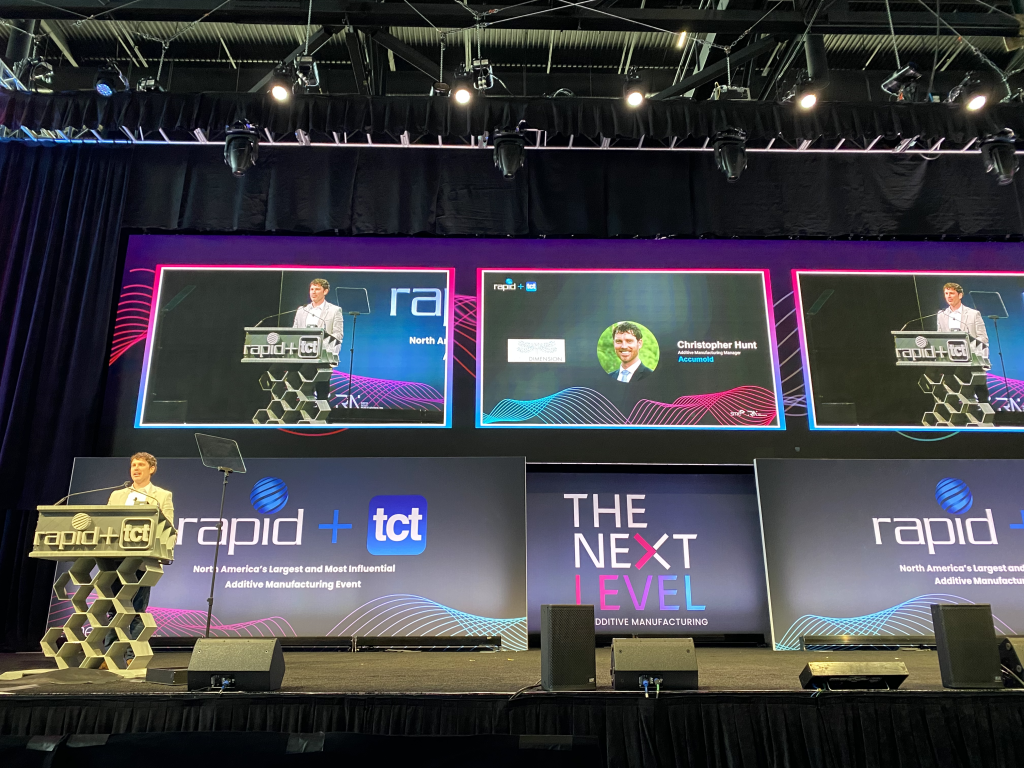
Additive Manufacturing and NASA
Leading the second keynote of RAPID+TCT 2023, Omar Mireles, a research and development engineer at NASA’s Marshall Space Flight Center, provided some insights into how AM has evolved, transitioned and developed across the aerospace industry.
Aerospace applications within Additive Manufacturing is certainly a relevant topic. Indeed, Relativity Space recently drew a lot of attention following their launch of the world’s first 3D printed rocket, the Terran 1. Throughout his talk, Mireles further highlighted exciting Additive Manufacturing applications within this vertical, claiming that “Additive is being infused into all NASA areas.”
Mireles outlined how 3D printing is already being used above the Earth’s surface, with NASA employing Additive technology on the ISS. A topology optimized manifold L-PBF AM Ti6A4V FDM platform is currently deployed on the space station, facilitating 3D printing on orbit, and reportedly allowing for 34% mass and 75% cost savings.
Additionally, once in orbit, NASA is reliant on the passive storage of fuel, keeping this material cold for long periods of time during missions. This cryogenic fuel management is challenging, with NASA requiring heat exchangers that are optimized, lightweight and thermally isolated to minimize heat loss. Therefore, Mireles also highlighted how NASA has produced L-PBF AM Ti6AI4V Cryo Lattice Struts using Additive technology. Moreover, an LP-DED AM A6061-RAM2 propellant tank with integral cooling channels has also been developed using Additive methods to reduce heat loss on orbit.
When in space, radiation can pose testing, and even potentially deadly, challenges. As such, shadow shields are employed, and NASA has been looking to hybrid Additive methods to approach the production of these shields. In fact, according to Mireles, NASA is generating “multi-physics topology optimized shields for this application”, using 3D printing to manufacture composite shields out of absorbent materials. With refractory Metal AM production “we finally have a tool we can hit back with”, commented Mireles.
Looking to the future, and NASA’s ongoing plans to travel to the moon and eventually mars, Mireles indicated that current technology still requires a good level of maturity, with Additive playing a key role in this process. For instance, NASA is exploring the potential applications of interplanetary 3D printing, with the potential for Additive technology to allow NASA astronauts to “live off the land”. In fact, Icon Olympus is already developing technology to print structures on the lunar surface. Mireles conceded that “this is not an easy nut to crack”, however acknowledged that such applications could open up a lot of opportunities. “This is an exciting time to be working within this field,” concluded Mireles.

HP’s new automation offering
Increasing automation, and reducing the need for human input, has already emerged as a key theme at RAPID+TCT 2023, and HP’s newest offering certainly feeds into this line. The multinational printing firm has launched their Jet Fusion 3D Powder Handling Automation Solution, and the Jet Fusion 3D Automation Accessory during this year’s event, with the company looking to “push the limits of workflow automation on the AM factory floor”.
HP’s new system for automated 3D powder handling is a pneumatically connected material processing system. The company claims that this closed-loop system can minimize labor, facilitate quality control and operation traceability, and provide a more efficient material flow.
Designed for customers with high volume production needs, the new HP Jet Fusion 3D Automation Accessory provides automated build unit exchange, allowing for two consecutive points to be conducted without any user input. Ultimately, this new offering offers the potential to minimize idle time between print jobs, and lower labor costs for customers by minimizing manual labor at night or over the weekend. What’s more, this offering can be automatized even further by integrating Autonomous Mobile Robots (AMR’s), such as Siemens’s SIMOVE system.
These new solutions build on the company’s automatic unpacking station, which was released back in 2020, to further automate the manufacturing workflow. Key industries for this new technology include customizable orthotics, such as dentures and arm splints, industrial equipment, and customizable automotive parts.

The Markforged PX100 Binder Jetting System
As with day one of this year’s RAPID+TCT, which saw the announcement of new machines from companies including Nexa3D and DMG Mori, new 3D printer system announcements have continued to fill the show floor today.
Markforged, a Massachusetts based 3D printer manufacturer specializing in metal 3D printers, today unveiled their new PX100 Binder Jetting machine. Produced in conjunction with Swedish based Digital Metal, this new machine combines high production speeds of 1,000 cm3 per hour with industry leading 1600 dpi part resolutions and static accuracy better than 1μm. As such, the PX100 offers the ability to produce small and incredibly complex parts for a number of key industries such as luxury goods, dental and medical, hardware manufacturing, and electronics.
Ross Adams, Markforged Business Development Manager, highlighted the medical sector as being particularly applicable. “There’s this trend around non invasive surgery, so being able to make smaller cuts and not invade the body as much, and I see binder jetting as a new avenue to have more design freedom to navigate these complex cavities inside the body.”
With this being the machine’s official launch in America, Markforged will begin shipping units later this year. In fact, according to Adams, the company has already received orders and is “getting some really good traction across different market segments”. For instance, one such customer is Azoth 3D, a contract manufacturer who specialize in binder jetting.
Looking to the future, Adams outlines the company’s long term vision as “production at the point of need.” “We imagine a bunch of mini factories basically within these printers that are producing parts directly where they’re needed,” continued Adams.
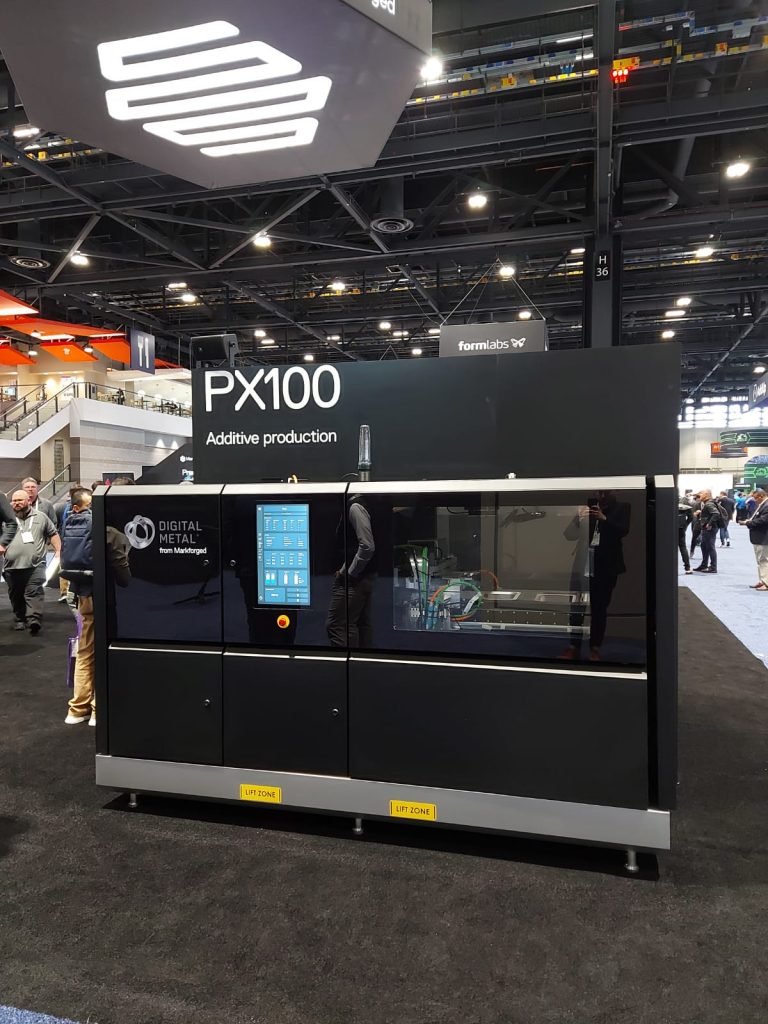
Mitsubishi’s AZ600 Metal DED printer
Continuing with the theme of metal 3D printing, MC Machinery Systems Inc. were showcasing the Mitsubishi AZ600 DED 3D printer today. Released in Japan last year, the company plans to expand availability to the US and Europe in the near future.
Possessing a print volume of 300 x 300 x 300 mm, this laser based system works by melting welding wires to 3D print near-net-shape metal parts. The AZ600 also incorporates a 5-axis spatial control system for complex geometry, and automatic defect compensation with the ability to precisely control the processing conditions of a build. As such, key industries for this machine include gas, automation, repair and aerospace. The AZ600 is available in two different models, the F20 version, with a 2kW oscillator, and the F40 version boasting a 4kW oscillator.
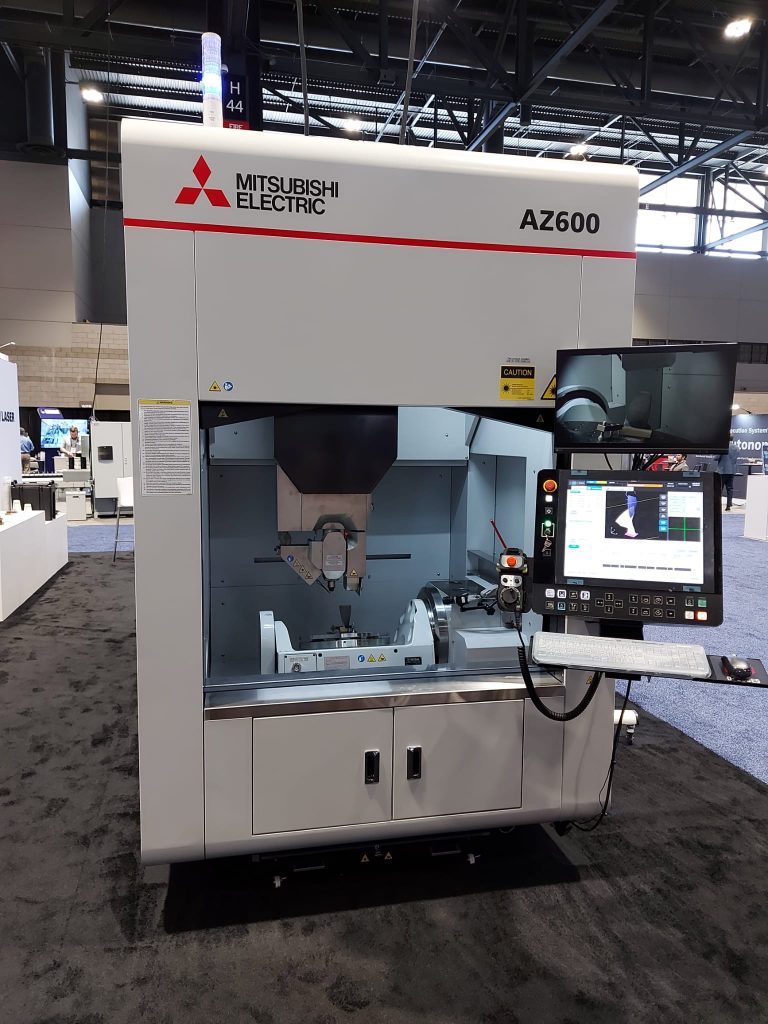
The Lumia X1 by Axtra 3D
Moving onto polymer based printers now, and another interesting machine on display was the Lumia X1 by Axtra 3D. This SLA printer, which is powered by HPS and TruLayer technologies, offers a 45 micron resolution, and a fairly substantial build size (XYZ) of 249 x 140 x 495 mm. Moreover, this machine also boasts good printing speeds, with printing times of 144 minutes, and only 18 minutes printing time per part.
“There’s a lot of competition out there and everyone has good solutions. But what we’re trying to do is improve the process,” commented Axtra 3D Founding member and Chief revenue Officer Paul Spoliansky. “So what we’ve done is we’ve created our own light engine that has both a laser and a DLP light engine in one, and they’re both the same wavelength and work in a synchronous fashion.”
By applying both light engines simultaneously, Spoliansky claims that this machine offers high productivity, high throughput, “and also incredible quality, surface quality, fine feature resolution and detail”. Having been in beta for almost a year, this machine is now on the market and available for purchase.
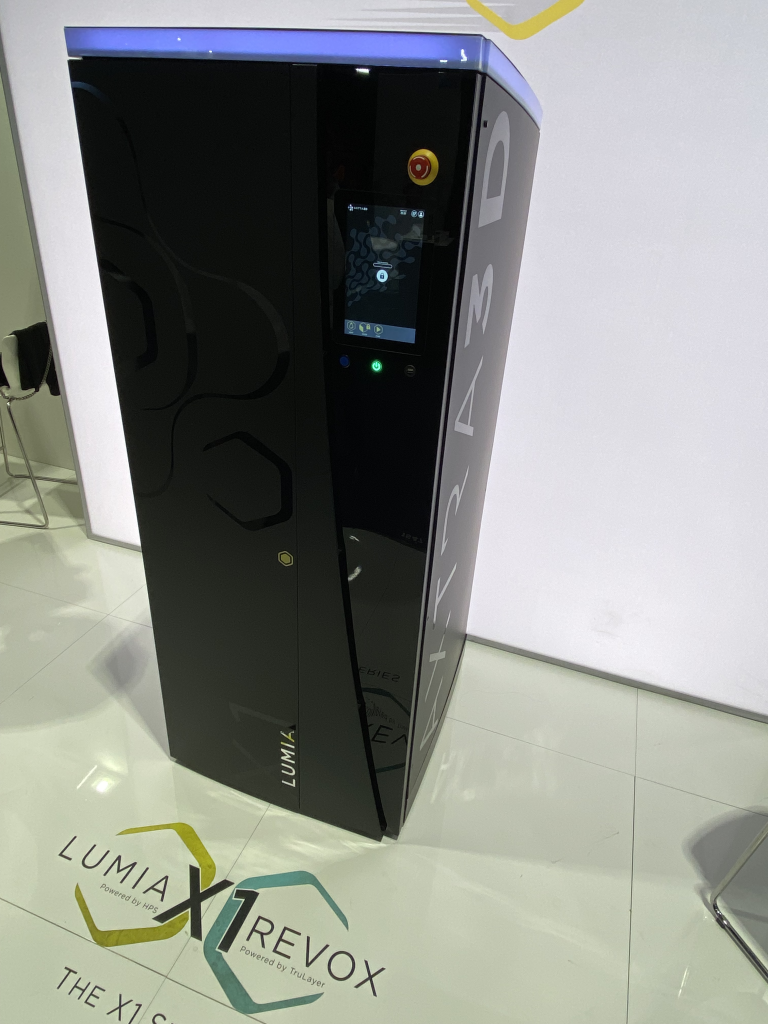
Ultimaker’s new brand identity
Since merging with Stratasys subsidiary Makerbot in 2022, Ultimaker has launched new branding for the new combined company. Retaining the Ultimaker name, the company is now segmenting based on customer needs, with Makerbot targeted towards the education sector, and Ultimaker focused on more professional applications. Within the Ultimaker segment, the company is offering two main product lines, the S Series, and the Method X.
Ultimaker CEO Nadav Goshen highlighted the challenges which followed the merger, calling the process very hectic, and very demanding. “Joining two companies together is hard. Joining them across the ocean is harder, and joining two competitors is probably the extreme,” claimed Goshen.
However, these challenges have reportedly been outweighed by the benefits. For one, the combination of resources has certainly been a net positive for the company, using available funds to develop better products as opposed to competing with one another. Additionally, Goshen points to customer demands as driving this merger. “The customer wants a wide portfolio from one vendor. So I think we’re covering both. We’re focusing on getting innovation, getting the diversity out there, and also on preserving the customers.”
Looking to the future, Goshen claims that the company will continue to grow organically, with new products in the pipeline and set to be released soon, “we have a lot of organic growth still within us” concluded Goshen.
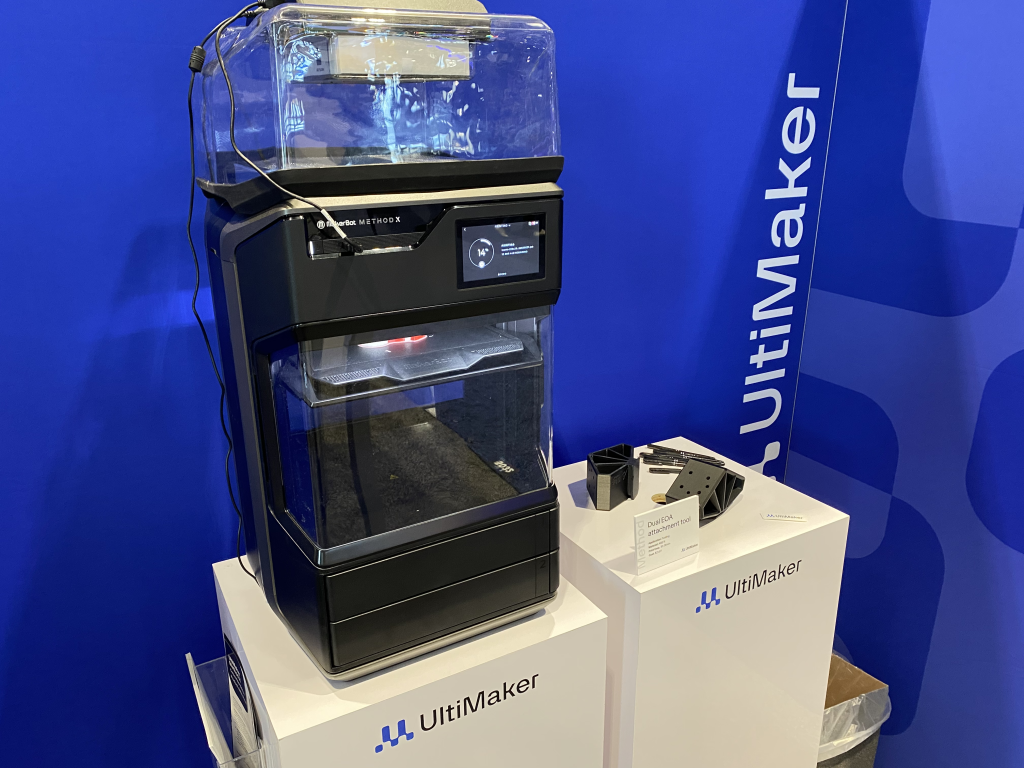
Inkbit and the “3D printing renaissance”
Finally, we managed to catch up with Davide Marini, CEO of multi-material 3D printer developer Inkbit, to discuss the company’s current direction and long term vision. Inkbit’s Inkbit Vista system is catered towards mass production of end-use polymer parts. The company offers multi-material printing capabilities, and incorporates a novel Vision-Controlled Jetting (VCJ) technology to enable high resolution printing.
In terms of the key verticals this technology benefits the most, Marini points to robotics. The very fact that Inkbit offers multi material printing makes it particularly well suited to this industry. As Marini points out, “any product that may require fluidics will benefit from having the ability to integrate gaskets in the design.”
Marini outlined Inkbit’s long term vision as “transforming how products are designed and manufactured,” and “enabling iteration on entire products, not just parts.” Additionally, Marini points to the significance of fast product development and integration in guiding the company’s direction, whilst also highlighting the creation of a “seamless transition from prototyping to manufacturing” as being particularly important.
“Typically when you think of mass production and mass manufacturing, assembly lines, typically the connotation is not very positive. We’re thinking of repetitive, manual jobs,” said Marini. However, through 3D printing, Marini sees manufacturing as being “completely democratized by creating all sorts of new venues for people to express their creativity and benefit from”, potentially ushering in a “3D printing renaissance” as a result.
Click for more recaps:
Day One 3D printing news from RAPID+TCT 2023
Day Three 3D printing news from RAPID+TCT 2023
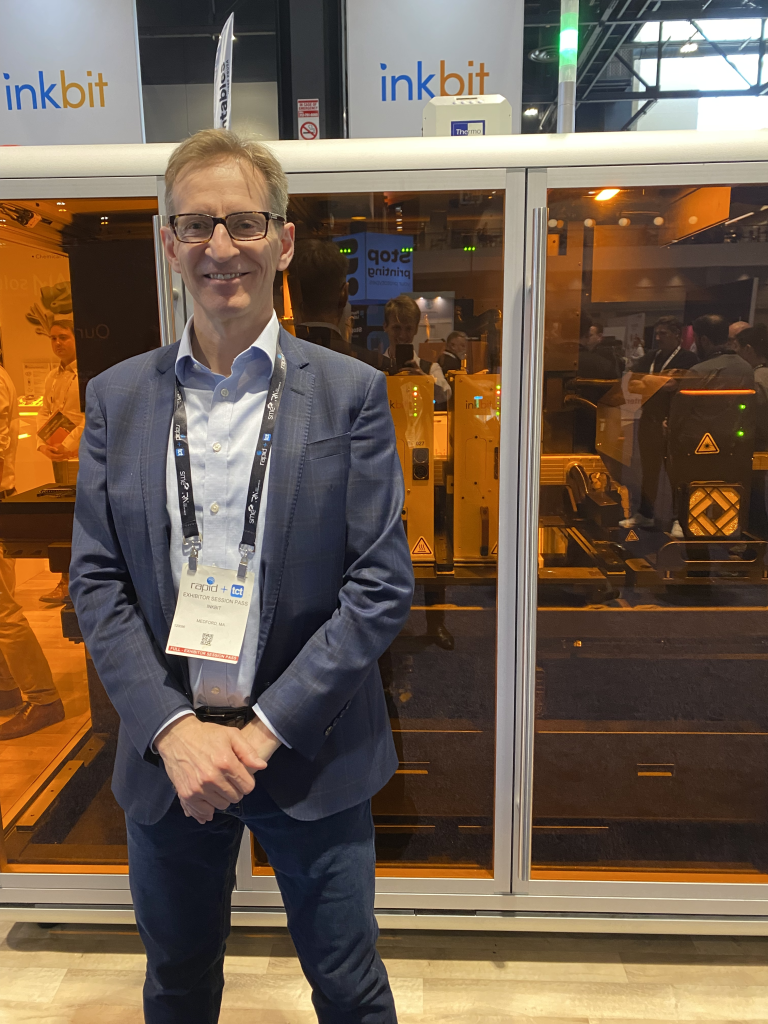
Subscribe to the 3D Printing Industry newsletter to ensure you keep up with the latest 3D printing news. You can also follow us on Twitter, like our Facebook page, and subscribe to the 3D Printing Industry Youtube channel to access more exclusive content.
Are you interested in working in the additive manufacturing industry? Visit 3D Printing Jobs to view a selection of available roles and kickstart your career.
Featured image shows the RAPID+TCT 2023 show floor on day 2. Photo by 3D Printing Industry.

